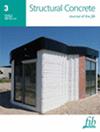奥匈帝国历史主义建筑中钢筋混凝土的早期应用
IF 3.3
3区 工程技术
Q2 CONSTRUCTION & BUILDING TECHNOLOGY
引用次数: 0
摘要
本研究探讨了钢筋混凝土在奥匈帝国历史主义建筑中的早期应用。研究时间跨度为 19 世纪末至 20 世纪初,揭示了这一时期的风格多元化以及钢筋混凝土的变革性影响。论文探讨了钢筋混凝土与传统形式的融合,提供了详细的案例研究和建筑实例。论文从多方面进行了探讨,包括钢筋混凝土在历史主义时期的演变、在著名建筑中的应用以及在当代文献中的记载。案例研究,如 Battyánd(现斯洛文尼亚 Puconci)的路德教会教堂、Topolya(现塞尔维亚 Bačka Topola)的罗马天主教堂和捷克 Český Krumlov 的前犹太教会堂,展示了钢筋混凝土在应对结构挑战的同时坚持历史主义美学的创新方式。研究最后反思了钢筋混凝土在挑战历史主义传统、为现代建筑表现形式铺平道路方面的变革作用。本文章由计算机程序翻译,如有差异,请以英文原文为准。
Early use of the reinforced concrete in the architecture of the Historicism in Austria–Hungary
The study examines the early incorporation of reinforced concrete in the architecture of Historicism in Austria–Hungary. Spanning the late 19th to early 20th centuries, the research illuminates the period's stylistic pluralism and the transformative impact of reinforced concrete. The paper examines the integration of reinforced concrete into traditional forms, providing detailed case studies and architectural examples. It navigates through various aspects, including the evolution of reinforced concrete during the historicist period, its adoption in notable structures, and its documentation in contemporary literature. Case studies, such as the Lutheran Church in Battyánd (now Puconci, Slovenia), the Roman Catholic Church in Topolya (now Bačka Topola, Serbia), and the former Synagogue in Český Krumlov, Czechia, showcase the innovative ways reinforced concrete addressed structural challenges while adhering to historicist aesthetics. The research concludes by reflecting on the transformative role of reinforced concrete in challenging the conventions of Historicism, paving the way for modern architectural expressions.
求助全文
通过发布文献求助,成功后即可免费获取论文全文。
去求助
来源期刊

Structural Concrete
CONSTRUCTION & BUILDING TECHNOLOGY-ENGINEERING, CIVIL
CiteScore
5.60
自引率
15.60%
发文量
284
审稿时长
3 months
期刊介绍:
Structural Concrete, the official journal of the fib, provides conceptual and procedural guidance in the field of concrete construction, and features peer-reviewed papers, keynote research and industry news covering all aspects of the design, construction, performance in service and demolition of concrete structures.
Main topics:
design, construction, performance in service, conservation (assessment, maintenance, strengthening) and demolition of concrete structures
research about the behaviour of concrete structures
development of design methods
fib Model Code
sustainability of concrete structures.
 求助内容:
求助内容: 应助结果提醒方式:
应助结果提醒方式:


